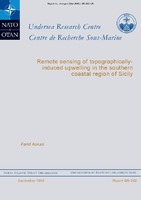Remote sensing of topographically-induced upwelling in the southern coastal region of Sicily

Abstract
Upwelling signatures caused by variations in bottom topography along the southeastern Sicilian coast are identified, using spaceborne remote sensing Advanced Very High Resolution Radiometer (AVHRR) imagery, ERS-1 and RADARSAT Synthetic Aperture Radar (SAR) imagery, Topex/Poseidon/ERS-2 (TPE) altimeter maps, and historical Coastal Zone Colour Scanner (CZCS) imagery. Topographically-induced upwelling appears to be a quasi-permanent feature along the southeastern coast of Sicily where sharp transitions occur in the bottom slopes. In AVHRR and historical CZCS imagery, upwelling signatures are manifested as 3 to 4 km wide bands of cold nutrient-rich waters running parallel to the shelfbreak. Collocated with the optical signatures, are steptype SAR modulations as well as bands of enhanced surface roughness the locations of which are coincident with topographic breaks in the bottom slope. On the downstream of the Malta Plateau is another prominent upwelling site which forms in concert with the arrivalof the Malta eddy, mainly during late summer and early fall. While the formation of the eddy is largely dependent on the strength of density stratification, the bottom topography is the important triggering agent. The eddy rotates cyclonically which contributes to upwelling, reducing the SST by about 1 to 2 C0 inside the eddy with respect to the ambient ocean. Historical CZCS imagery also show increases in pigment concentrations associated with the eddy. In TPE altimeter maps, the eddy is manifested as a 40 to 50 km wide "bowl-shaped" structure, with negative sea height anomalies ranging between 6 to 10 cm. The eddy-type motion is further evidenced in SAR imagery by the appearance of striations forming within the center and the boundaries of the eddy. The study demonstrates the utility of sensor fusion and identifies a set of genetic indicators for upwelling identification and tracking using multiple sensors.
Report Number
SR-282Date
1998/09Author(s)
Askari, Farid